Analysis of Doctrine of Frustration in Business
VerifiedAdded on 2020/10/23
|12
|3716
|290
AI Summary
The provided document is a solved assignment that delves into the concept of the doctrine of frustration in business. It highlights the significance of this doctrine in imposing liability on parties attempting to take benefits without rightful ownership. The analysis also touches upon various forms of organizational structures, emphasizing the importance for investors to choose suitable options based on their preferences. This document is suitable for students seeking comprehensive insights into the doctrine of frustration and its applications in business.
Contribute Materials
Your contribution can guide someone’s learning journey. Share your
documents today.
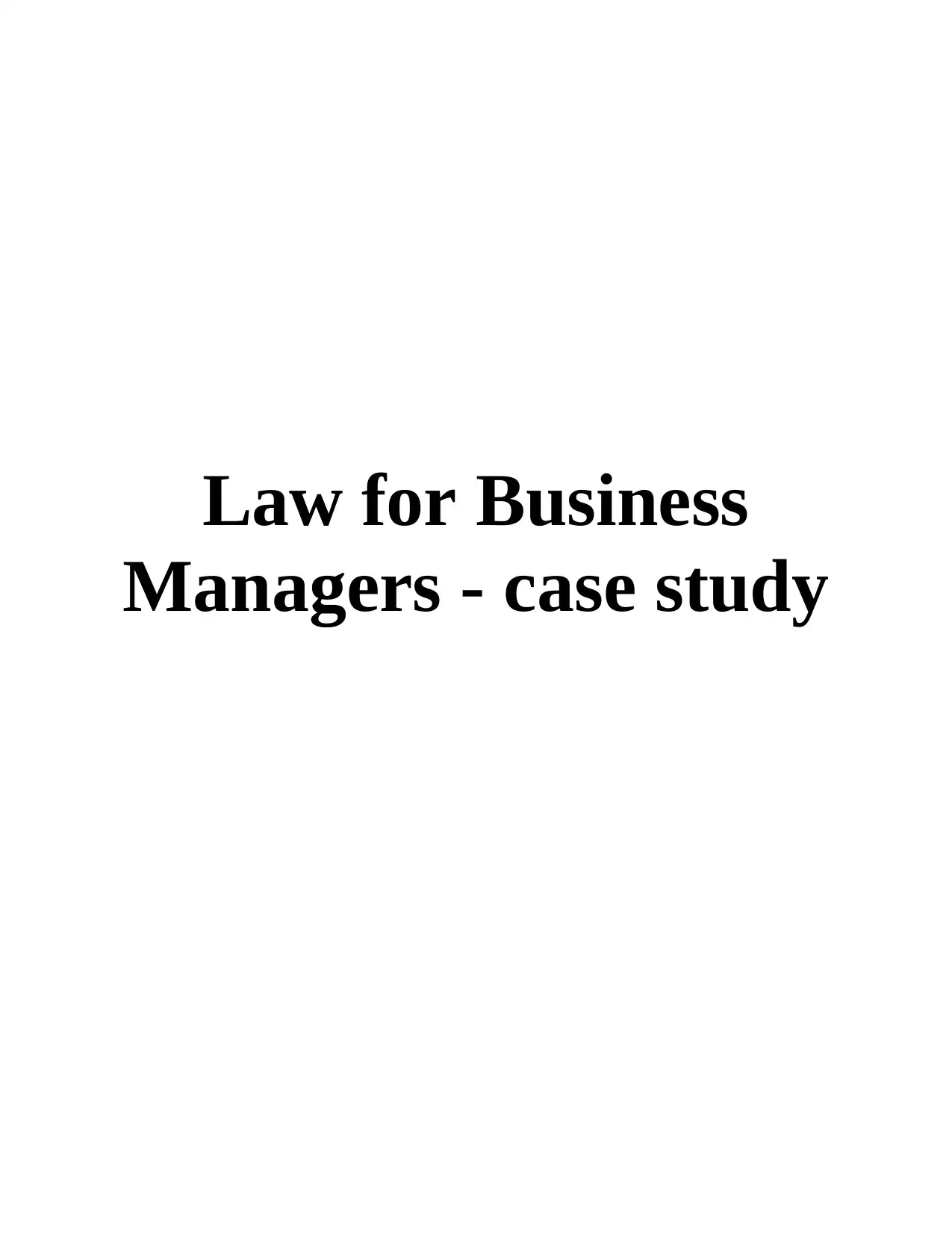
Law for Business
Managers - case study
Managers - case study
Secure Best Marks with AI Grader
Need help grading? Try our AI Grader for instant feedback on your assignments.
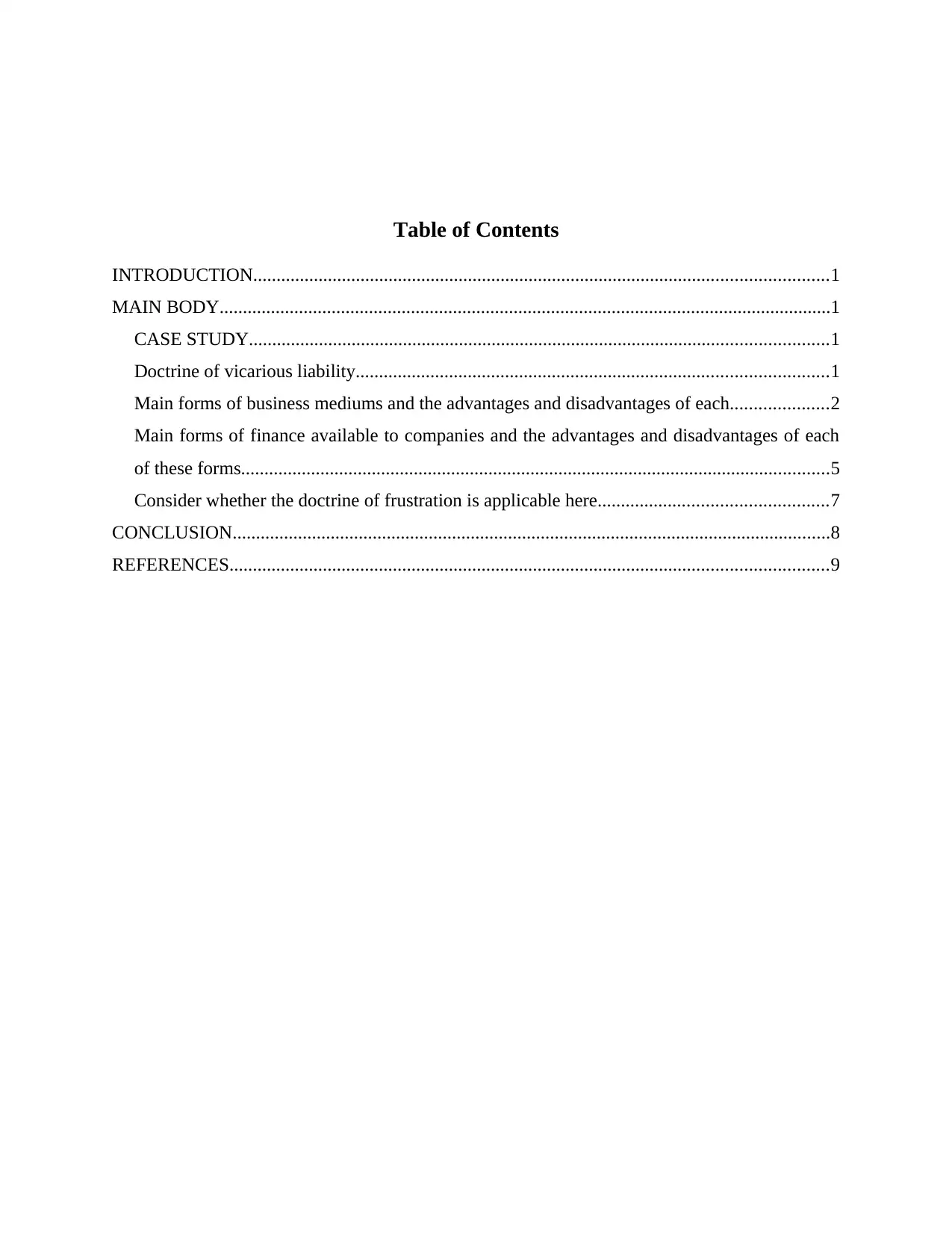
Table of Contents
INTRODUCTION...........................................................................................................................1
MAIN BODY...................................................................................................................................1
CASE STUDY............................................................................................................................1
Doctrine of vicarious liability.....................................................................................................1
Main forms of business mediums and the advantages and disadvantages of each.....................2
Main forms of finance available to companies and the advantages and disadvantages of each
of these forms..............................................................................................................................5
Consider whether the doctrine of frustration is applicable here.................................................7
CONCLUSION................................................................................................................................8
REFERENCES................................................................................................................................9
INTRODUCTION...........................................................................................................................1
MAIN BODY...................................................................................................................................1
CASE STUDY............................................................................................................................1
Doctrine of vicarious liability.....................................................................................................1
Main forms of business mediums and the advantages and disadvantages of each.....................2
Main forms of finance available to companies and the advantages and disadvantages of each
of these forms..............................................................................................................................5
Consider whether the doctrine of frustration is applicable here.................................................7
CONCLUSION................................................................................................................................8
REFERENCES................................................................................................................................9

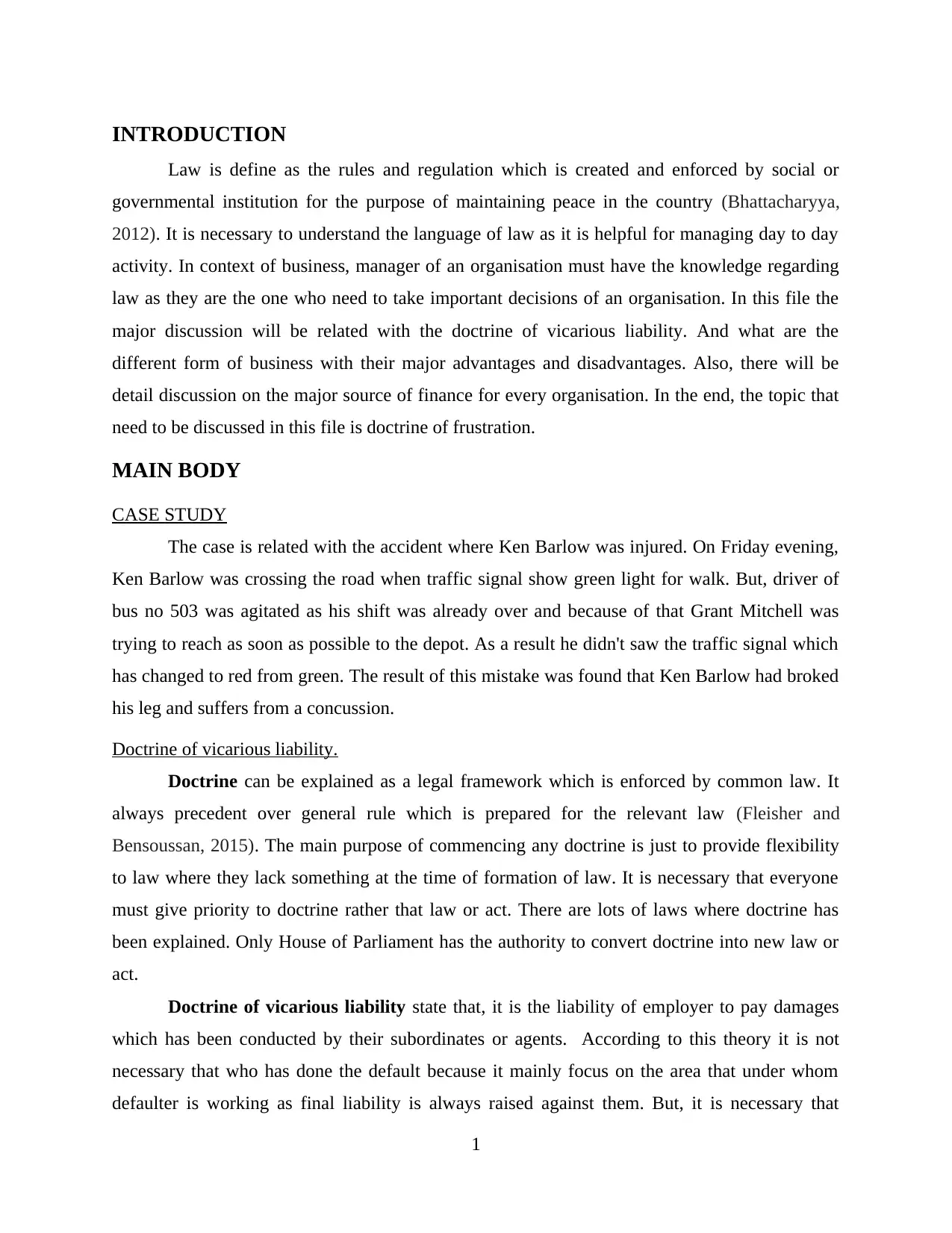
INTRODUCTION
Law is define as the rules and regulation which is created and enforced by social or
governmental institution for the purpose of maintaining peace in the country (Bhattacharyya,
2012). It is necessary to understand the language of law as it is helpful for managing day to day
activity. In context of business, manager of an organisation must have the knowledge regarding
law as they are the one who need to take important decisions of an organisation. In this file the
major discussion will be related with the doctrine of vicarious liability. And what are the
different form of business with their major advantages and disadvantages. Also, there will be
detail discussion on the major source of finance for every organisation. In the end, the topic that
need to be discussed in this file is doctrine of frustration.
MAIN BODY
CASE STUDY
The case is related with the accident where Ken Barlow was injured. On Friday evening,
Ken Barlow was crossing the road when traffic signal show green light for walk. But, driver of
bus no 503 was agitated as his shift was already over and because of that Grant Mitchell was
trying to reach as soon as possible to the depot. As a result he didn't saw the traffic signal which
has changed to red from green. The result of this mistake was found that Ken Barlow had broked
his leg and suffers from a concussion.
Doctrine of vicarious liability.
Doctrine can be explained as a legal framework which is enforced by common law. It
always precedent over general rule which is prepared for the relevant law (Fleisher and
Bensoussan, 2015). The main purpose of commencing any doctrine is just to provide flexibility
to law where they lack something at the time of formation of law. It is necessary that everyone
must give priority to doctrine rather that law or act. There are lots of laws where doctrine has
been explained. Only House of Parliament has the authority to convert doctrine into new law or
act.
Doctrine of vicarious liability state that, it is the liability of employer to pay damages
which has been conducted by their subordinates or agents. According to this theory it is not
necessary that who has done the default because it mainly focus on the area that under whom
defaulter is working as final liability is always raised against them. But, it is necessary that
1
Law is define as the rules and regulation which is created and enforced by social or
governmental institution for the purpose of maintaining peace in the country (Bhattacharyya,
2012). It is necessary to understand the language of law as it is helpful for managing day to day
activity. In context of business, manager of an organisation must have the knowledge regarding
law as they are the one who need to take important decisions of an organisation. In this file the
major discussion will be related with the doctrine of vicarious liability. And what are the
different form of business with their major advantages and disadvantages. Also, there will be
detail discussion on the major source of finance for every organisation. In the end, the topic that
need to be discussed in this file is doctrine of frustration.
MAIN BODY
CASE STUDY
The case is related with the accident where Ken Barlow was injured. On Friday evening,
Ken Barlow was crossing the road when traffic signal show green light for walk. But, driver of
bus no 503 was agitated as his shift was already over and because of that Grant Mitchell was
trying to reach as soon as possible to the depot. As a result he didn't saw the traffic signal which
has changed to red from green. The result of this mistake was found that Ken Barlow had broked
his leg and suffers from a concussion.
Doctrine of vicarious liability.
Doctrine can be explained as a legal framework which is enforced by common law. It
always precedent over general rule which is prepared for the relevant law (Fleisher and
Bensoussan, 2015). The main purpose of commencing any doctrine is just to provide flexibility
to law where they lack something at the time of formation of law. It is necessary that everyone
must give priority to doctrine rather that law or act. There are lots of laws where doctrine has
been explained. Only House of Parliament has the authority to convert doctrine into new law or
act.
Doctrine of vicarious liability state that, it is the liability of employer to pay damages
which has been conducted by their subordinates or agents. According to this theory it is not
necessary that who has done the default because it mainly focus on the area that under whom
defaulter is working as final liability is always raised against them. But, it is necessary that
1
Secure Best Marks with AI Grader
Need help grading? Try our AI Grader for instant feedback on your assignments.
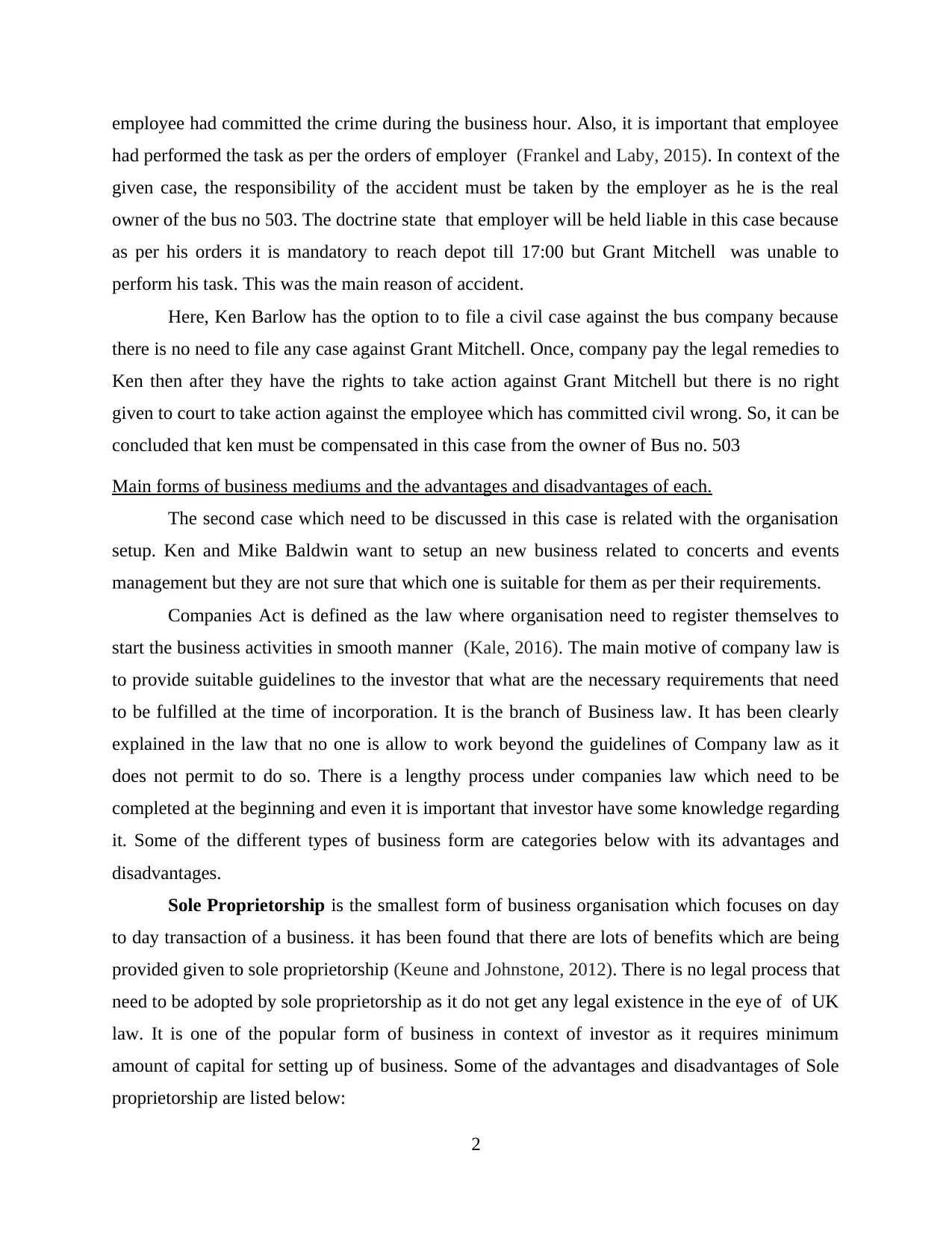
employee had committed the crime during the business hour. Also, it is important that employee
had performed the task as per the orders of employer (Frankel and Laby, 2015). In context of the
given case, the responsibility of the accident must be taken by the employer as he is the real
owner of the bus no 503. The doctrine state that employer will be held liable in this case because
as per his orders it is mandatory to reach depot till 17:00 but Grant Mitchell was unable to
perform his task. This was the main reason of accident.
Here, Ken Barlow has the option to to file a civil case against the bus company because
there is no need to file any case against Grant Mitchell. Once, company pay the legal remedies to
Ken then after they have the rights to take action against Grant Mitchell but there is no right
given to court to take action against the employee which has committed civil wrong. So, it can be
concluded that ken must be compensated in this case from the owner of Bus no. 503
Main forms of business mediums and the advantages and disadvantages of each.
The second case which need to be discussed in this case is related with the organisation
setup. Ken and Mike Baldwin want to setup an new business related to concerts and events
management but they are not sure that which one is suitable for them as per their requirements.
Companies Act is defined as the law where organisation need to register themselves to
start the business activities in smooth manner (Kale, 2016). The main motive of company law is
to provide suitable guidelines to the investor that what are the necessary requirements that need
to be fulfilled at the time of incorporation. It is the branch of Business law. It has been clearly
explained in the law that no one is allow to work beyond the guidelines of Company law as it
does not permit to do so. There is a lengthy process under companies law which need to be
completed at the beginning and even it is important that investor have some knowledge regarding
it. Some of the different types of business form are categories below with its advantages and
disadvantages.
Sole Proprietorship is the smallest form of business organisation which focuses on day
to day transaction of a business. it has been found that there are lots of benefits which are being
provided given to sole proprietorship (Keune and Johnstone, 2012). There is no legal process that
need to be adopted by sole proprietorship as it do not get any legal existence in the eye of of UK
law. It is one of the popular form of business in context of investor as it requires minimum
amount of capital for setting up of business. Some of the advantages and disadvantages of Sole
proprietorship are listed below:
2
had performed the task as per the orders of employer (Frankel and Laby, 2015). In context of the
given case, the responsibility of the accident must be taken by the employer as he is the real
owner of the bus no 503. The doctrine state that employer will be held liable in this case because
as per his orders it is mandatory to reach depot till 17:00 but Grant Mitchell was unable to
perform his task. This was the main reason of accident.
Here, Ken Barlow has the option to to file a civil case against the bus company because
there is no need to file any case against Grant Mitchell. Once, company pay the legal remedies to
Ken then after they have the rights to take action against Grant Mitchell but there is no right
given to court to take action against the employee which has committed civil wrong. So, it can be
concluded that ken must be compensated in this case from the owner of Bus no. 503
Main forms of business mediums and the advantages and disadvantages of each.
The second case which need to be discussed in this case is related with the organisation
setup. Ken and Mike Baldwin want to setup an new business related to concerts and events
management but they are not sure that which one is suitable for them as per their requirements.
Companies Act is defined as the law where organisation need to register themselves to
start the business activities in smooth manner (Kale, 2016). The main motive of company law is
to provide suitable guidelines to the investor that what are the necessary requirements that need
to be fulfilled at the time of incorporation. It is the branch of Business law. It has been clearly
explained in the law that no one is allow to work beyond the guidelines of Company law as it
does not permit to do so. There is a lengthy process under companies law which need to be
completed at the beginning and even it is important that investor have some knowledge regarding
it. Some of the different types of business form are categories below with its advantages and
disadvantages.
Sole Proprietorship is the smallest form of business organisation which focuses on day
to day transaction of a business. it has been found that there are lots of benefits which are being
provided given to sole proprietorship (Keune and Johnstone, 2012). There is no legal process that
need to be adopted by sole proprietorship as it do not get any legal existence in the eye of of UK
law. It is one of the popular form of business in context of investor as it requires minimum
amount of capital for setting up of business. Some of the advantages and disadvantages of Sole
proprietorship are listed below:
2
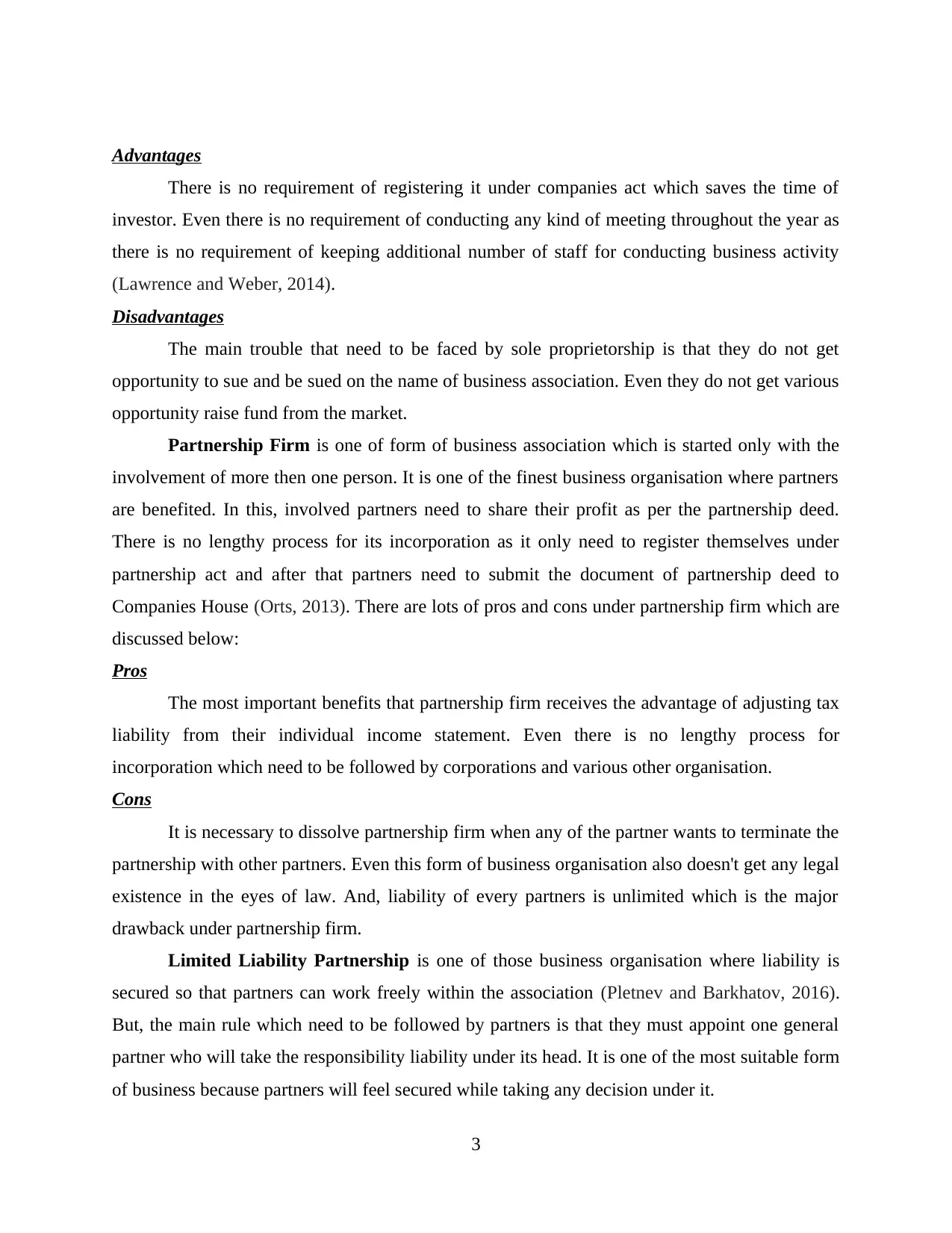
Advantages
There is no requirement of registering it under companies act which saves the time of
investor. Even there is no requirement of conducting any kind of meeting throughout the year as
there is no requirement of keeping additional number of staff for conducting business activity
(Lawrence and Weber, 2014).
Disadvantages
The main trouble that need to be faced by sole proprietorship is that they do not get
opportunity to sue and be sued on the name of business association. Even they do not get various
opportunity raise fund from the market.
Partnership Firm is one of form of business association which is started only with the
involvement of more then one person. It is one of the finest business organisation where partners
are benefited. In this, involved partners need to share their profit as per the partnership deed.
There is no lengthy process for its incorporation as it only need to register themselves under
partnership act and after that partners need to submit the document of partnership deed to
Companies House (Orts, 2013). There are lots of pros and cons under partnership firm which are
discussed below:
Pros
The most important benefits that partnership firm receives the advantage of adjusting tax
liability from their individual income statement. Even there is no lengthy process for
incorporation which need to be followed by corporations and various other organisation.
Cons
It is necessary to dissolve partnership firm when any of the partner wants to terminate the
partnership with other partners. Even this form of business organisation also doesn't get any legal
existence in the eyes of law. And, liability of every partners is unlimited which is the major
drawback under partnership firm.
Limited Liability Partnership is one of those business organisation where liability is
secured so that partners can work freely within the association (Pletnev and Barkhatov, 2016).
But, the main rule which need to be followed by partners is that they must appoint one general
partner who will take the responsibility liability under its head. It is one of the most suitable form
of business because partners will feel secured while taking any decision under it.
3
There is no requirement of registering it under companies act which saves the time of
investor. Even there is no requirement of conducting any kind of meeting throughout the year as
there is no requirement of keeping additional number of staff for conducting business activity
(Lawrence and Weber, 2014).
Disadvantages
The main trouble that need to be faced by sole proprietorship is that they do not get
opportunity to sue and be sued on the name of business association. Even they do not get various
opportunity raise fund from the market.
Partnership Firm is one of form of business association which is started only with the
involvement of more then one person. It is one of the finest business organisation where partners
are benefited. In this, involved partners need to share their profit as per the partnership deed.
There is no lengthy process for its incorporation as it only need to register themselves under
partnership act and after that partners need to submit the document of partnership deed to
Companies House (Orts, 2013). There are lots of pros and cons under partnership firm which are
discussed below:
Pros
The most important benefits that partnership firm receives the advantage of adjusting tax
liability from their individual income statement. Even there is no lengthy process for
incorporation which need to be followed by corporations and various other organisation.
Cons
It is necessary to dissolve partnership firm when any of the partner wants to terminate the
partnership with other partners. Even this form of business organisation also doesn't get any legal
existence in the eyes of law. And, liability of every partners is unlimited which is the major
drawback under partnership firm.
Limited Liability Partnership is one of those business organisation where liability is
secured so that partners can work freely within the association (Pletnev and Barkhatov, 2016).
But, the main rule which need to be followed by partners is that they must appoint one general
partner who will take the responsibility liability under its head. It is one of the most suitable form
of business because partners will feel secured while taking any decision under it.
3

Advantages
It gets the opportunity to secure its liability which attracts the investors to invest in
limited liability partnership. Do not requires to follow any legal formate while conducting
meeting as there is no requirement of it.
Disadvantages
There is one the major drawback under Limited Liability that partners must select one of
the partner who need to take the responsibility of liability of firm. Even they also don't get the
right of legal existence.
Joint Venture is one of that business form where major planning is of completing the
project on time with the help of many organisation. It is one of that form of business where profit
can be earned in more amount (Png, 2017). It is mainly done by partnership firm and limited
companies. There is a lengthy process of incorporation of joint venture where involved parties
need to select the name of joint venture and it is necessary to authorised person who need to take
the responsibility of project. Even it is also necessary that joint ventured company provide the
information that up to how long they will conduct the business activity for the completion of
project. Some of the advantages and disadvantages of joint venture are:
Advantages
The opportunity of earning profit and utilising the resources increase in joint venture. The
time duration to complete any particular task decreases as maximum number of workers are
involved under it.
Disadvantages
There are lots of chances of occurring dispute between joint ventured company.
Sometimes, if project fails because of certain reason then non of the company wants to take the
responsibility of it.
Limited Liability Company (LLC) is one of those organisation where combination of
different organisation can be seen. The main motive behind incorporating LLC is to secure the
liability of the member (Posner, 2014). The combination of Partnership firm and company can
only be found in Limited liability of company.
Advantages
The main advantage that LLC enjoy is related with the Legal existence as it do get the
chance to register themselves and they are legal in the eyes of court.
4
It gets the opportunity to secure its liability which attracts the investors to invest in
limited liability partnership. Do not requires to follow any legal formate while conducting
meeting as there is no requirement of it.
Disadvantages
There is one the major drawback under Limited Liability that partners must select one of
the partner who need to take the responsibility of liability of firm. Even they also don't get the
right of legal existence.
Joint Venture is one of that business form where major planning is of completing the
project on time with the help of many organisation. It is one of that form of business where profit
can be earned in more amount (Png, 2017). It is mainly done by partnership firm and limited
companies. There is a lengthy process of incorporation of joint venture where involved parties
need to select the name of joint venture and it is necessary to authorised person who need to take
the responsibility of project. Even it is also necessary that joint ventured company provide the
information that up to how long they will conduct the business activity for the completion of
project. Some of the advantages and disadvantages of joint venture are:
Advantages
The opportunity of earning profit and utilising the resources increase in joint venture. The
time duration to complete any particular task decreases as maximum number of workers are
involved under it.
Disadvantages
There are lots of chances of occurring dispute between joint ventured company.
Sometimes, if project fails because of certain reason then non of the company wants to take the
responsibility of it.
Limited Liability Company (LLC) is one of those organisation where combination of
different organisation can be seen. The main motive behind incorporating LLC is to secure the
liability of the member (Posner, 2014). The combination of Partnership firm and company can
only be found in Limited liability of company.
Advantages
The main advantage that LLC enjoy is related with the Legal existence as it do get the
chance to register themselves and they are legal in the eyes of court.
4
Paraphrase This Document
Need a fresh take? Get an instant paraphrase of this document with our AI Paraphraser
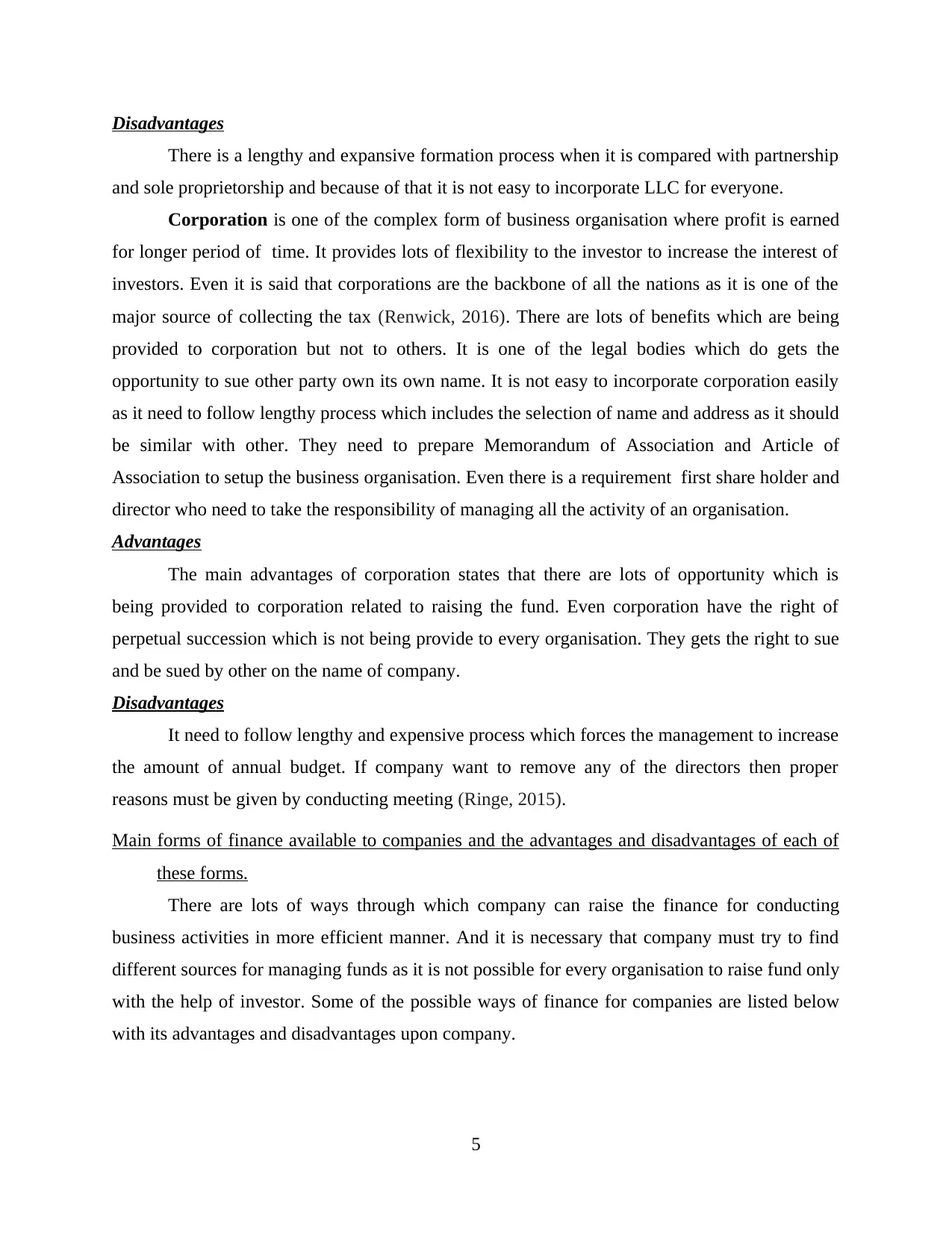
Disadvantages
There is a lengthy and expansive formation process when it is compared with partnership
and sole proprietorship and because of that it is not easy to incorporate LLC for everyone.
Corporation is one of the complex form of business organisation where profit is earned
for longer period of time. It provides lots of flexibility to the investor to increase the interest of
investors. Even it is said that corporations are the backbone of all the nations as it is one of the
major source of collecting the tax (Renwick, 2016). There are lots of benefits which are being
provided to corporation but not to others. It is one of the legal bodies which do gets the
opportunity to sue other party own its own name. It is not easy to incorporate corporation easily
as it need to follow lengthy process which includes the selection of name and address as it should
be similar with other. They need to prepare Memorandum of Association and Article of
Association to setup the business organisation. Even there is a requirement first share holder and
director who need to take the responsibility of managing all the activity of an organisation.
Advantages
The main advantages of corporation states that there are lots of opportunity which is
being provided to corporation related to raising the fund. Even corporation have the right of
perpetual succession which is not being provide to every organisation. They gets the right to sue
and be sued by other on the name of company.
Disadvantages
It need to follow lengthy and expensive process which forces the management to increase
the amount of annual budget. If company want to remove any of the directors then proper
reasons must be given by conducting meeting (Ringe, 2015).
Main forms of finance available to companies and the advantages and disadvantages of each of
these forms.
There are lots of ways through which company can raise the finance for conducting
business activities in more efficient manner. And it is necessary that company must try to find
different sources for managing funds as it is not possible for every organisation to raise fund only
with the help of investor. Some of the possible ways of finance for companies are listed below
with its advantages and disadvantages upon company.
5
There is a lengthy and expansive formation process when it is compared with partnership
and sole proprietorship and because of that it is not easy to incorporate LLC for everyone.
Corporation is one of the complex form of business organisation where profit is earned
for longer period of time. It provides lots of flexibility to the investor to increase the interest of
investors. Even it is said that corporations are the backbone of all the nations as it is one of the
major source of collecting the tax (Renwick, 2016). There are lots of benefits which are being
provided to corporation but not to others. It is one of the legal bodies which do gets the
opportunity to sue other party own its own name. It is not easy to incorporate corporation easily
as it need to follow lengthy process which includes the selection of name and address as it should
be similar with other. They need to prepare Memorandum of Association and Article of
Association to setup the business organisation. Even there is a requirement first share holder and
director who need to take the responsibility of managing all the activity of an organisation.
Advantages
The main advantages of corporation states that there are lots of opportunity which is
being provided to corporation related to raising the fund. Even corporation have the right of
perpetual succession which is not being provide to every organisation. They gets the right to sue
and be sued by other on the name of company.
Disadvantages
It need to follow lengthy and expensive process which forces the management to increase
the amount of annual budget. If company want to remove any of the directors then proper
reasons must be given by conducting meeting (Ringe, 2015).
Main forms of finance available to companies and the advantages and disadvantages of each of
these forms.
There are lots of ways through which company can raise the finance for conducting
business activities in more efficient manner. And it is necessary that company must try to find
different sources for managing funds as it is not possible for every organisation to raise fund only
with the help of investor. Some of the possible ways of finance for companies are listed below
with its advantages and disadvantages upon company.
5
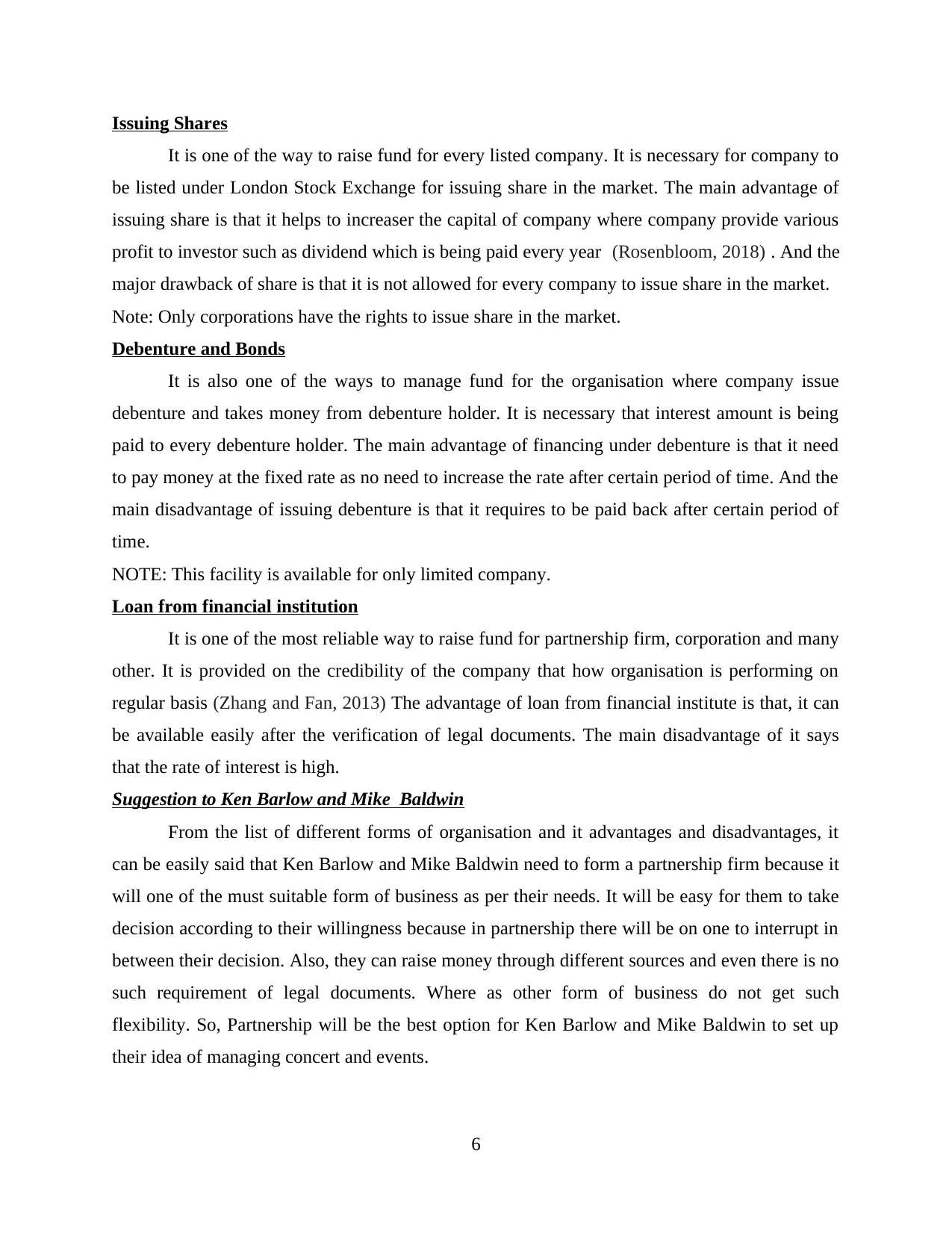
Issuing Shares
It is one of the way to raise fund for every listed company. It is necessary for company to
be listed under London Stock Exchange for issuing share in the market. The main advantage of
issuing share is that it helps to increaser the capital of company where company provide various
profit to investor such as dividend which is being paid every year (Rosenbloom, 2018) . And the
major drawback of share is that it is not allowed for every company to issue share in the market.
Note: Only corporations have the rights to issue share in the market.
Debenture and Bonds
It is also one of the ways to manage fund for the organisation where company issue
debenture and takes money from debenture holder. It is necessary that interest amount is being
paid to every debenture holder. The main advantage of financing under debenture is that it need
to pay money at the fixed rate as no need to increase the rate after certain period of time. And the
main disadvantage of issuing debenture is that it requires to be paid back after certain period of
time.
NOTE: This facility is available for only limited company.
Loan from financial institution
It is one of the most reliable way to raise fund for partnership firm, corporation and many
other. It is provided on the credibility of the company that how organisation is performing on
regular basis (Zhang and Fan, 2013) The advantage of loan from financial institute is that, it can
be available easily after the verification of legal documents. The main disadvantage of it says
that the rate of interest is high.
Suggestion to Ken Barlow and Mike Baldwin
From the list of different forms of organisation and it advantages and disadvantages, it
can be easily said that Ken Barlow and Mike Baldwin need to form a partnership firm because it
will one of the must suitable form of business as per their needs. It will be easy for them to take
decision according to their willingness because in partnership there will be on one to interrupt in
between their decision. Also, they can raise money through different sources and even there is no
such requirement of legal documents. Where as other form of business do not get such
flexibility. So, Partnership will be the best option for Ken Barlow and Mike Baldwin to set up
their idea of managing concert and events.
6
It is one of the way to raise fund for every listed company. It is necessary for company to
be listed under London Stock Exchange for issuing share in the market. The main advantage of
issuing share is that it helps to increaser the capital of company where company provide various
profit to investor such as dividend which is being paid every year (Rosenbloom, 2018) . And the
major drawback of share is that it is not allowed for every company to issue share in the market.
Note: Only corporations have the rights to issue share in the market.
Debenture and Bonds
It is also one of the ways to manage fund for the organisation where company issue
debenture and takes money from debenture holder. It is necessary that interest amount is being
paid to every debenture holder. The main advantage of financing under debenture is that it need
to pay money at the fixed rate as no need to increase the rate after certain period of time. And the
main disadvantage of issuing debenture is that it requires to be paid back after certain period of
time.
NOTE: This facility is available for only limited company.
Loan from financial institution
It is one of the most reliable way to raise fund for partnership firm, corporation and many
other. It is provided on the credibility of the company that how organisation is performing on
regular basis (Zhang and Fan, 2013) The advantage of loan from financial institute is that, it can
be available easily after the verification of legal documents. The main disadvantage of it says
that the rate of interest is high.
Suggestion to Ken Barlow and Mike Baldwin
From the list of different forms of organisation and it advantages and disadvantages, it
can be easily said that Ken Barlow and Mike Baldwin need to form a partnership firm because it
will one of the must suitable form of business as per their needs. It will be easy for them to take
decision according to their willingness because in partnership there will be on one to interrupt in
between their decision. Also, they can raise money through different sources and even there is no
such requirement of legal documents. Where as other form of business do not get such
flexibility. So, Partnership will be the best option for Ken Barlow and Mike Baldwin to set up
their idea of managing concert and events.
6

Consider whether the doctrine of frustration is applicable here.
Case Study: This case is related with default in repayment. Here, Ken and Mike have
successfully incorporated their company where they need to conduct a concert by Elvis Jackson.
Liz had purchased the ticket of concert and it was found that concert didn't took place as Elvis
died just three days before the date of concert. Liz is not happy with this new and because of this
he want a refund of ticket which he had purchased from Ken and Mike. But Ken and Mike are
refusing to pay the money of ticket which they had sold to Liz. The reason which was given by
them is “ there is no fault of them and because of that they will not refund any amount of
money”.
Doctrine of Frustration states that no one is entitled to receive unnecessary benefits in
which there is no right of that person. It this situation, no one is allowed to retain the money and
other benefits which have been derived from other people (The Doctrine of "Frustration", 2018).
It will be counted as invalid and illegal if anyone takes this kind of benefits. Some of the famous
cases have also occurred related to Doctrine of Frustration i.e. Taylor v. Cardwell, Paradine v.
Jane. In all this case it was decided by the honourable judges that it is necessary to pay back the
amount if it is not possible happening of event doesn't exist.
In Doctrine of Frustration, it is necessary that non of the party is suffering from losses as
there was no intention of of both the party to do fraud with each other. The main feature of this
principle says that it discharges all of the involved party from future liability and even it ends the
term and condition of a contract automatically (Stark and Vedres, 2012).. The legal effect of
Frustration states that even common law don't have the power in this condition to order the
involved party to say that it is necessary to complete the term and condition of contract as
existence of contract doesn't exist in this situation In the above case, it can be said that it is
necessary to pay 100 GBP to Liz as there was no fault of his. Although, it can be said that there
was no fault of Ken and Mike, still they are not allowed to receive profit of that part on which
there is no right of them. Yes, it falls under the category of doctrine of frustration. It is necessary
to understand that Ken and Mike must return the amount of ticket else Liz has the option to take
legal action against them to claim the amount of money from them. If anyone breaches the
principle of Frustration then innocent party have the option to sue the party to claim damages.
7
Case Study: This case is related with default in repayment. Here, Ken and Mike have
successfully incorporated their company where they need to conduct a concert by Elvis Jackson.
Liz had purchased the ticket of concert and it was found that concert didn't took place as Elvis
died just three days before the date of concert. Liz is not happy with this new and because of this
he want a refund of ticket which he had purchased from Ken and Mike. But Ken and Mike are
refusing to pay the money of ticket which they had sold to Liz. The reason which was given by
them is “ there is no fault of them and because of that they will not refund any amount of
money”.
Doctrine of Frustration states that no one is entitled to receive unnecessary benefits in
which there is no right of that person. It this situation, no one is allowed to retain the money and
other benefits which have been derived from other people (The Doctrine of "Frustration", 2018).
It will be counted as invalid and illegal if anyone takes this kind of benefits. Some of the famous
cases have also occurred related to Doctrine of Frustration i.e. Taylor v. Cardwell, Paradine v.
Jane. In all this case it was decided by the honourable judges that it is necessary to pay back the
amount if it is not possible happening of event doesn't exist.
In Doctrine of Frustration, it is necessary that non of the party is suffering from losses as
there was no intention of of both the party to do fraud with each other. The main feature of this
principle says that it discharges all of the involved party from future liability and even it ends the
term and condition of a contract automatically (Stark and Vedres, 2012).. The legal effect of
Frustration states that even common law don't have the power in this condition to order the
involved party to say that it is necessary to complete the term and condition of contract as
existence of contract doesn't exist in this situation In the above case, it can be said that it is
necessary to pay 100 GBP to Liz as there was no fault of his. Although, it can be said that there
was no fault of Ken and Mike, still they are not allowed to receive profit of that part on which
there is no right of them. Yes, it falls under the category of doctrine of frustration. It is necessary
to understand that Ken and Mike must return the amount of ticket else Liz has the option to take
legal action against them to claim the amount of money from them. If anyone breaches the
principle of Frustration then innocent party have the option to sue the party to claim damages.
7
Secure Best Marks with AI Grader
Need help grading? Try our AI Grader for instant feedback on your assignments.
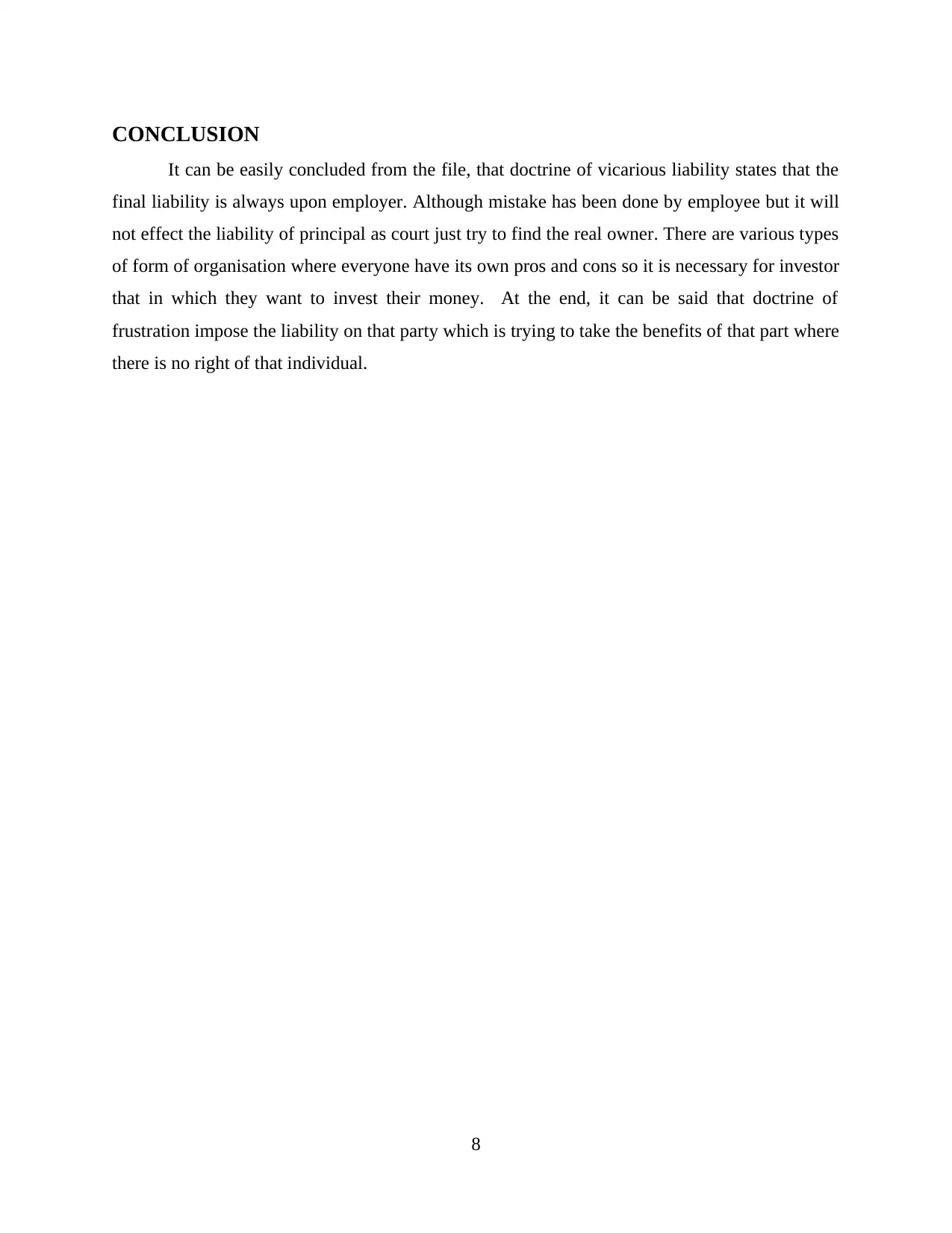
CONCLUSION
It can be easily concluded from the file, that doctrine of vicarious liability states that the
final liability is always upon employer. Although mistake has been done by employee but it will
not effect the liability of principal as court just try to find the real owner. There are various types
of form of organisation where everyone have its own pros and cons so it is necessary for investor
that in which they want to invest their money. At the end, it can be said that doctrine of
frustration impose the liability on that party which is trying to take the benefits of that part where
there is no right of that individual.
8
It can be easily concluded from the file, that doctrine of vicarious liability states that the
final liability is always upon employer. Although mistake has been done by employee but it will
not effect the liability of principal as court just try to find the real owner. There are various types
of form of organisation where everyone have its own pros and cons so it is necessary for investor
that in which they want to invest their money. At the end, it can be said that doctrine of
frustration impose the liability on that party which is trying to take the benefits of that part where
there is no right of that individual.
8
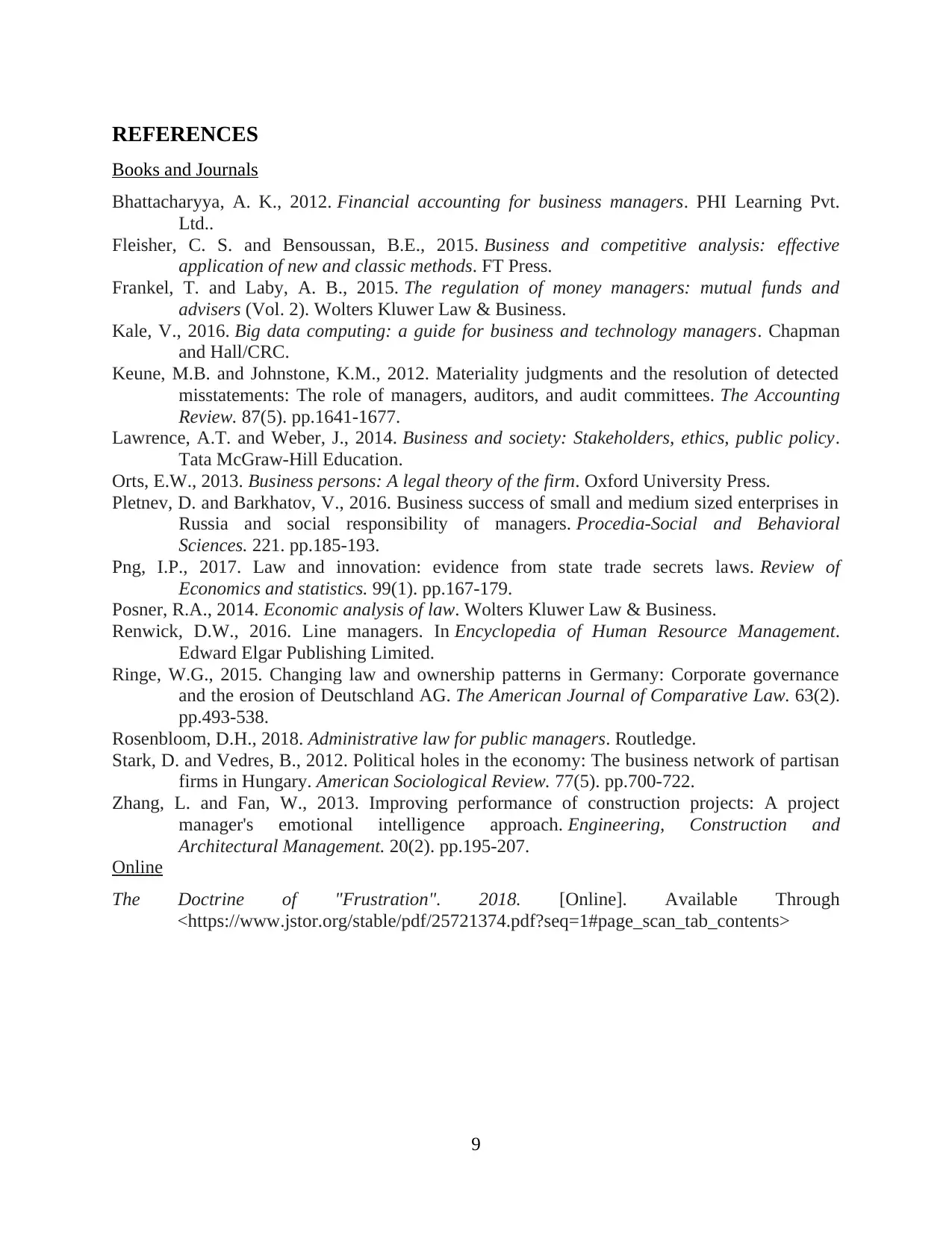
REFERENCES
Books and Journals
Bhattacharyya, A. K., 2012. Financial accounting for business managers. PHI Learning Pvt.
Ltd..
Fleisher, C. S. and Bensoussan, B.E., 2015. Business and competitive analysis: effective
application of new and classic methods. FT Press.
Frankel, T. and Laby, A. B., 2015. The regulation of money managers: mutual funds and
advisers (Vol. 2). Wolters Kluwer Law & Business.
Kale, V., 2016. Big data computing: a guide for business and technology managers. Chapman
and Hall/CRC.
Keune, M.B. and Johnstone, K.M., 2012. Materiality judgments and the resolution of detected
misstatements: The role of managers, auditors, and audit committees. The Accounting
Review. 87(5). pp.1641-1677.
Lawrence, A.T. and Weber, J., 2014. Business and society: Stakeholders, ethics, public policy.
Tata McGraw-Hill Education.
Orts, E.W., 2013. Business persons: A legal theory of the firm. Oxford University Press.
Pletnev, D. and Barkhatov, V., 2016. Business success of small and medium sized enterprises in
Russia and social responsibility of managers. Procedia-Social and Behavioral
Sciences. 221. pp.185-193.
Png, I.P., 2017. Law and innovation: evidence from state trade secrets laws. Review of
Economics and statistics. 99(1). pp.167-179.
Posner, R.A., 2014. Economic analysis of law. Wolters Kluwer Law & Business.
Renwick, D.W., 2016. Line managers. In Encyclopedia of Human Resource Management.
Edward Elgar Publishing Limited.
Ringe, W.G., 2015. Changing law and ownership patterns in Germany: Corporate governance
and the erosion of Deutschland AG. The American Journal of Comparative Law. 63(2).
pp.493-538.
Rosenbloom, D.H., 2018. Administrative law for public managers. Routledge.
Stark, D. and Vedres, B., 2012. Political holes in the economy: The business network of partisan
firms in Hungary. American Sociological Review. 77(5). pp.700-722.
Zhang, L. and Fan, W., 2013. Improving performance of construction projects: A project
manager's emotional intelligence approach. Engineering, Construction and
Architectural Management. 20(2). pp.195-207.
Online
The Doctrine of "Frustration". 2018. [Online]. Available Through
<https://www.jstor.org/stable/pdf/25721374.pdf?seq=1#page_scan_tab_contents>
9
Books and Journals
Bhattacharyya, A. K., 2012. Financial accounting for business managers. PHI Learning Pvt.
Ltd..
Fleisher, C. S. and Bensoussan, B.E., 2015. Business and competitive analysis: effective
application of new and classic methods. FT Press.
Frankel, T. and Laby, A. B., 2015. The regulation of money managers: mutual funds and
advisers (Vol. 2). Wolters Kluwer Law & Business.
Kale, V., 2016. Big data computing: a guide for business and technology managers. Chapman
and Hall/CRC.
Keune, M.B. and Johnstone, K.M., 2012. Materiality judgments and the resolution of detected
misstatements: The role of managers, auditors, and audit committees. The Accounting
Review. 87(5). pp.1641-1677.
Lawrence, A.T. and Weber, J., 2014. Business and society: Stakeholders, ethics, public policy.
Tata McGraw-Hill Education.
Orts, E.W., 2013. Business persons: A legal theory of the firm. Oxford University Press.
Pletnev, D. and Barkhatov, V., 2016. Business success of small and medium sized enterprises in
Russia and social responsibility of managers. Procedia-Social and Behavioral
Sciences. 221. pp.185-193.
Png, I.P., 2017. Law and innovation: evidence from state trade secrets laws. Review of
Economics and statistics. 99(1). pp.167-179.
Posner, R.A., 2014. Economic analysis of law. Wolters Kluwer Law & Business.
Renwick, D.W., 2016. Line managers. In Encyclopedia of Human Resource Management.
Edward Elgar Publishing Limited.
Ringe, W.G., 2015. Changing law and ownership patterns in Germany: Corporate governance
and the erosion of Deutschland AG. The American Journal of Comparative Law. 63(2).
pp.493-538.
Rosenbloom, D.H., 2018. Administrative law for public managers. Routledge.
Stark, D. and Vedres, B., 2012. Political holes in the economy: The business network of partisan
firms in Hungary. American Sociological Review. 77(5). pp.700-722.
Zhang, L. and Fan, W., 2013. Improving performance of construction projects: A project
manager's emotional intelligence approach. Engineering, Construction and
Architectural Management. 20(2). pp.195-207.
Online
The Doctrine of "Frustration". 2018. [Online]. Available Through
<https://www.jstor.org/stable/pdf/25721374.pdf?seq=1#page_scan_tab_contents>
9
1 out of 12
Related Documents
Your All-in-One AI-Powered Toolkit for Academic Success.
+13062052269
info@desklib.com
Available 24*7 on WhatsApp / Email
![[object Object]](/_next/static/media/star-bottom.7253800d.svg)
Unlock your academic potential
© 2024 | Zucol Services PVT LTD | All rights reserved.





